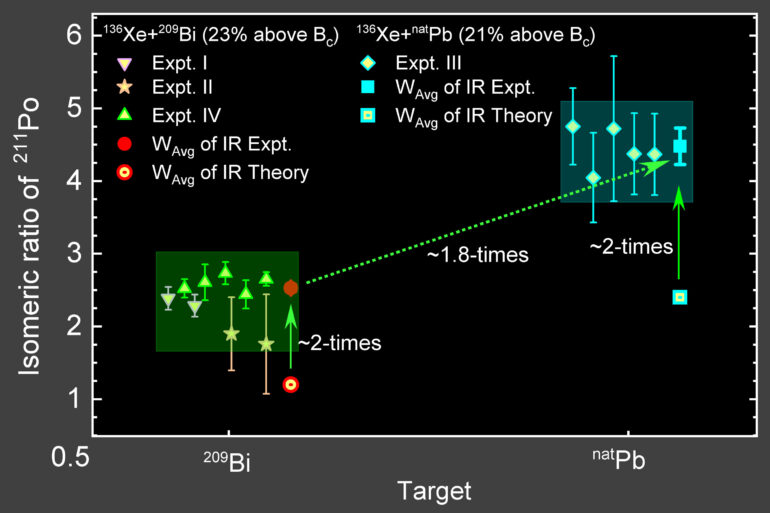Delving into the intricate properties of heavy neutron-rich nuclei is crucial since they have the potential to reshape our understanding of nuclear physics and astrophysics.
Determining the nuclear properties of these exotic nuclei is like piecing together a complex puzzle to understand the evolution or possible quenching of nuclear shell structures. These structures play a significant role in astrophysical processes like the rapid neutron capture process (r-process), which is essential for forming heavy elements in the universe.
Why multinucleon-transfer (MNT) reactions?
Production of heavy exotic nuclei, which are far from the stability line of the nuclear Segrè chart, is incredibly challenging with conventional reaction methods like fusion-evaporation, fusion-fission or fragmentation. That is why finding a way to unlock their secrets through multinucleon-transfer (MNT) reactions is essential.
The MNT reactions involve the exchange of multiple protons and neutrons between interacting systems at energies around the Coulomb barrier, allowing the population of projectile-like/target-like fragments (PLFs/TLFs). Hence, neutron-rich heavy beams, preferably intense radioactive ion beams (RIBs), targeting neutron-rich nuclei can populate neutron-rich PLF/TLF nuclei with high-spin isomeric states at low excitation energies.
Recent studies, both experimental and theoretical, have demonstrated that MNT reactions hold tremendous potential to access these exotic nuclei of the terra incognita region. Our international research team has conducted a series of MNT experiments at the Ion-Guide Isotope Separator On-Line (IGISOL), University of Jyväskylä (Finland). In addition to the general commissioning of the setup, we have collected the data to understand the reaction mechanism better.
Our work is published in the journal Physics Letters B.
Nuclear isomers
One of the most intriguing aspects of our study involves isomers, which are long-living excited states in nuclei. By studying the relative production of these isomers relative to their ground states, known as isomeric ratios (IRs), we gain valuable insights into nuclear structure and the underlying reaction mechanism. Our work is the first experimental and theoretical study on the IRs of nuclei created from two different proton transfer (p-transfer) channels via two different MNT reactions.
Through our study, we aimed to answer several questions: How does the spin of the target or nucleon transfers affect the high-spin isomer population? How accurately can state-of-the-art MNT model calculations explain our observations? What gaps remain in our understanding of these processes? These questions are essential for deciphering the spin distributions of MNT fragments, which, in turn, influence the population of isomers.
How could we determine the isomer ratios?
In our experiments, we used intense neutron-rich xenon (136Xe) beams (~1011 particle/sec) delivered by the K-130 cyclotron at JYFL and shot them on a lead (natPb) or bismuth (209Bi) target. We conducted four distinct experiments utilizing specialized detection systems (gas-filled stopping cells).
By capturing the heavy MNT fragments within helium-filled gas cells, we could extract, accelerate, and separate these MNT ions in order to filter out a particular ion of interest— in the present case, the ions with mass number A=211. We identified these products using alpha-decay spectroscopy and observed consistent alpha-decay spectra of polonium-211 in both ground and isomeric states across various measured conditions in different experiments.
What do the isomer ratios tell us?
Our findings revealed a significantly larger production of polonium-211 isomers relative to ground states in studied MNT reactions. In addition, comparative results from different MNT reactions showed an enhanced production of polonium-211 isomer formed from 2p-transfer over 1p-transfer. Deduced results indicate a strong correlation between the isomer production and the p-transfer production routes.
Furthermore, meticulous comparative analysis of isomer production from different types of reaction processes over an extended projectile mass range reveals that the two entrance-channel parameters— projectile mass and p-transfer channels, strongly influence the population of the high-spin isomer in polonium-211. The state-of-the-art Langevin-type MNT model calculations qualitatively predict the deduced relative enhancement in the isomer population. However, more experiments are necessary in order to refine these models further.
Importance of collaborative efforts
The journey toward the unknown territory of terra incognita region via MNT reactions is both challenging and exhilarating. The collaborative efforts of many experimentalists and theoretical physicists were important in understanding the production mechanism of isomers and comprehending the angular momentum distributions of MNT fragments.
As a next step, we plan to produce neutron-rich exotic nuclei near the neutron shell closure N=126 for precision mass measurements.
This story is part of Science X Dialog, where researchers can report findings from their published research articles. Visit this page for information about Science X Dialog and how to participate.
More information:
D. Kumar, T. Dickel, A. Zadvornaya, O. Beliuskina, A. Kankainen et al, First investigation on the isomeric ratio in multinucleon transfer reactions: Entrance channel effects on the spin distribution, Physics Letters B (2024). DOI: 10.1016/j.physletb.2024.138654
Deepak Kumar is a postdoctoral researcher at GSI Helmholtzzentrum für Schwerionenforschung GmbH (Germany). Formerly, Kumar worked as a postdoctoral research scientist at the Flerov Laboratory of Nuclear Reactions (FLNR), JINR, Dubna (Russia) and pursued a Ph.D. at the Indian Institute of Technology Roorkee (IITR), India. Kumar broadly works on the production and study of unknown neutron-rich exotic nuclei via multinucleon transfer (MNT), fission-like processes underlying heavy and superheavy nuclei, deciphering the reaction dynamics of intermediate-mass nuclei using heavy-ion-induced reactions, and exploring prospects for radionuclides relevant in medical physics applications.
Citation:
Physicists report first measured isomeric-ratio in multinucleon-transfer reactions: A doorway to access terra incognita (2024, July 8)



